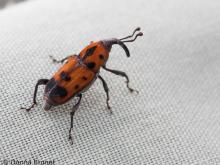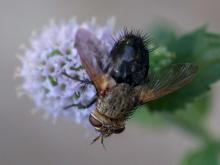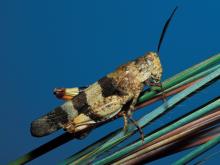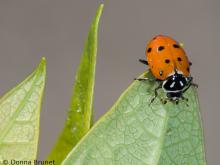Land Invertebrates
Media

Species Types
Scientific Name
Rhodobaenus quinquepunctatus
Description
The cocklebur weevil is about ¼ to ½ inch long. The larvae bore inside the stems and roots of cocklebur, ragweed, and other plants in the sunflower family.
Media

Species Types
Scientific Name
About 1,350 species in North America north of Mexico
Description
Tachinid flies are one of the largest families of flies. They are parasitic flies whose larvae are parasitoids of other insects. They look a lot like house flies, blow or bottle flies, wasps, or bees. Many are very bristly.
Media

Species Types
Scientific Name
Neacoryphus bicrucis
Description
The white-crossed seed bug, or ragwort seed bug, has a prominent thin-lined pale X dividing zones of red and black. Look for it in places where ragworts are plentiful.
Media

Species Types
Scientific Name
Lygaeus kalmii
Description
The small milkweed bug is one common type of seed bug. It is found on many more plants than just milkweeds.
Media

Species Types
Scientific Name
Hadrotettix trifasciatus
Description
The three-banded grasshopper is one of our most attractively marked grasshoppers, with three sharply marked dark bands.
Media

Species Types
Scientific Name
Tetraopes spp.
Description
Milkweed longhorns are a genus of longhorned beetles that feed on milkweed. They are red with black spots. The species are very similar.
Media

Species Types
Scientific Name
Araneus marmoreus
Description
The marbled orbweaver is sometimes called the “pumpkin spider” because its rounded abdomen is sometimes bright orange. The color and markings can vary greatly.
Media

Species Types
Scientific Name
Hippodamia convergens
Description
One of our many native lady beetles, the convergent lady beetle is named for two short white lines on the black pronotum (shoulderlike section behind the head) that converge toward each other.
Media

Species Types
Scientific Name
Cycloneda munda
Description
The polished lady beetle lacks spots. One of our many native lady beetles, it eats aphids, which endears it to gardeners and farmers.
Media

Species Types
Scientific Name
Neoharmonia venusta
Description
The V-marked lady beetle, one of our many native lady beetles, is very attractive. The pattern and coloration can vary greatly among individuals, but most in this species have a V on the back.
See Also



Media

Species Types
Scientific Name
Cisseps fulvicollis
Description
The yellow-collared scape moth is more often “orange-collared.” And whether you think it looks more like a firefly or a wasp, it’s still a moth!
Media

Species Types
Scientific Name
Nearly 150 species in North America north of Mexico
Description
Slim, delicate plume moths are instantly recognizable by their T-shaped silhouette, long legs, and muted shades of tan and brown. It can be hard to separate the various species.
Media

Species Types
Scientific Name
Pyrrharctia isabella
Description
Not many people know the adult Isabella tiger moth when they see one, but we’re all acquainted with its caterpillar, the woolly worm, or woolly bear.
About Land Invertebrates in Missouri
Invertebrates are animals without backbones, including earthworms, slugs, snails, and arthropods. Arthropods—invertebrates with “jointed legs” — are a group of invertebrates that includes crayfish, shrimp, millipedes, centipedes, mites, spiders, and insects. There may be as many as 10 million species of insects alive on earth today, and they probably constitute more than 90 percent all animal species.





















